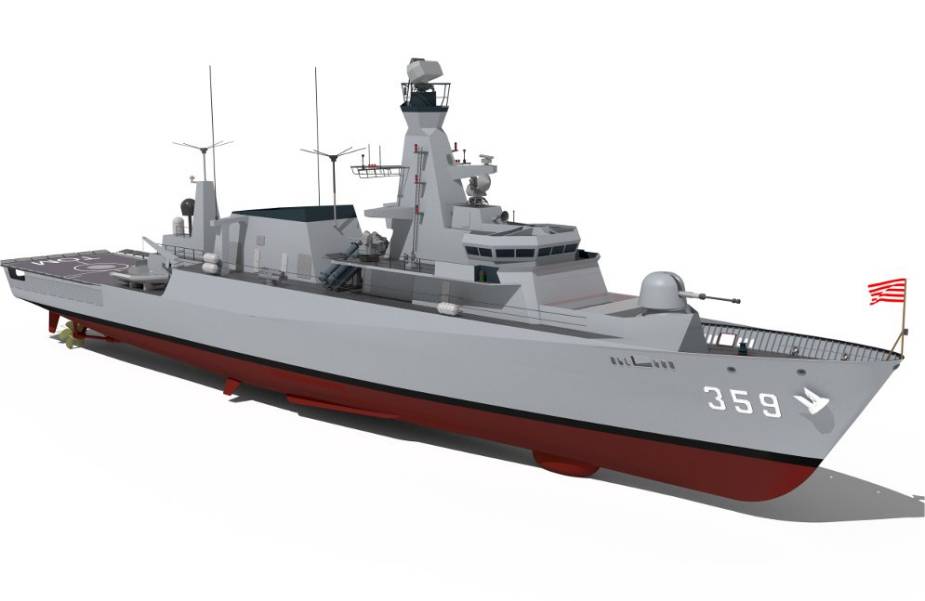According to a press release published by Thales, the company is working alongside the Indonesian Navy to modernize its multi-role light frigate KRI Usman-Harun with open-architecture systems to guarantee effectiveness for decades to come.
Follow Navy Recognition on Google News at this link
 Drawing of the modernized version of the Indonesian navy multi-role light frigate KRI Usman-Harun. (Picture source Thales)
Drawing of the modernized version of the Indonesian navy multi-role light frigate KRI Usman-Harun. (Picture source Thales)
The KDB Usman Harun is the second ship of the Nakhoda Ragam class and was originally built for the Royal Brunei Navy and was ultimately bought by the Indonesia Navy and renamed KRI Usman Harun. Usman Harun is the third ship of the Bung Tomo class.
Dating from the 1990s, the corvette had reached a point where it no longer feasible to maintain the aging electronics of its mission systems. But the ministry knew that its plan to refit and reintegrate the bulk of the ship’s onboard systems wouldn’t be easy. The complexity was far greater than for a new-build project – and no contract for a novice. As the project moved towards the competitive tendering stage, thoughts turned logically to Thales. Indonesia’s navy had recent, highly positive experience with Thales systems on its new Raden Eddy Martadinata Class frigates. Moreover, Thales could offer a cast-iron record in major warship refits – from the Netherlands and Germany, to Thailand and Columbia.
Thales saw the opportunity to help a long-term customer clarify its needs and complete the feasibility work needed. The company drew on strong relations with local Indonesian players – eventually partnering with state-owned enterprise PT Len Industri (Persero), to offer a solid local base and a channel to transfer hi-tech expertise into the country. Thales and PT Len assembled an array of specialists – ranging from experts in electronic warfare, to systems integration and platform engineering by Dutch naval architect Nevesbu. Together, they carried out comprehensive analysis and onboard survey work to produce the detailed blueprint for an integrated set of systems that would bring the frigate bang up to date.
The combination of rigour, experience, and local excellence was a winning formula. In addition, the systems’ commonality with those on other Indonesian ships would reduce training time and facilitate management and maintenance. An ambitious final specification was drawn up, including Thales’s latest-generation TACTICOS Combat Management System, SMART-S Mk2 3D and STIR 1.2 EO Mk2 radars, a Vigile Mk2 ESM, and two new tactical data links – Link Y Mk2 and a tactical data link that will be wholly delivered by PT Len, providing connectivity to Indonesia’s military communications network and enabling the corvette to play its full part in wider naval task forces. Existing weaponry will also be fully integrated, and a new VL MICA surface-to-air missile system added – a significant boost for vessel self-defence.
TACTICOS is at the heart of the upgrade, bringing a step change in performance through its advanced data-processing and presentation abilities. Determined to deliver excellence, Thales also worked hard to ensure that the TACTICOS Maritime Security module could be included within the project’s budget, a feature that will provide vital intelligence by enabling interrogation of the international AIS and ADSB databases of aircraft and shipping. The AI-assisted analysis will automatically alert operators to unusual behavior at sea or in the sky – moving the needle further from reconnaissance to intelligence.
In March 2020, Indonesia’s defence ministry formally launched the modernization, signing an agreement with lead contractor, PT Len, and Thales, to upgrade KRI Usman-Harun – with completion expected by 2023. The project will see Indonesia’s navy equipped with a highly capable and robust ship whose open-architecture systems will guarantee effectiveness for decades to come – whether protecting Indonesia’s economic interests or supporting task forces in wider missions.



